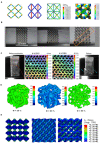Porous Scaffold Design for Additive Manufacturing in Orthopedics: A Review
- PMID: 32626698
- PMCID: PMC7311579
- DOI: 10.3389/fbioe.2020.00609
Porous Scaffold Design for Additive Manufacturing in Orthopedics: A Review
Abstract
With the increasing application of orthopedic scaffolds, a dramatically increasing number of requirements for scaffolds are precise. The porous structure has been a fundamental design in the bone tissue engineering or orthopedic clinics because of its low Young's modulus, high compressive strength, and abundant cell accommodation space. The porous structure manufactured by additive manufacturing (AM) technology has controllable pore size, pore shape, and porosity. The single unit can be designed and arrayed with AM, which brings controllable pore characteristics and mechanical properties. This paper presents the current status of porous designs in AM technology. The porous structures are stated from the cellular structure and the whole structure. In the aspect of the cellular structure, non-parametric design and parametric design are discussed here according to whether the algorithm generates the structure or not. The non-parametric design comprises the diamond, the body-centered cubic, and the polyhedral structure, etc. The Voronoi, the Triply Periodic Minimal Surface, and other parametric designs are mainly discussed in parametric design. In the discussion of cellular structures, we emphasize the design, and the resulting biomechanical and biological effects caused by designs. In the aspect of the whole structure, the recent experimental researches are reviewed on uniform design, layered gradient design, and layered gradient design based on topological optimization, etc. These parts are summarized because of the development of technology and the demand for mechanics or bone growth. Finally, the challenges faced by the porous designs and prospects of porous structure in orthopedics are proposed in this paper.
Keywords: additive manufacturing; cellular design; mechanical property; orthopedic scaffolds; porous structure design.
Copyright © 2020 Chen, Han, Wang, Liu, Chen and Wang.
Figures






References
-
- Abueidda D. W., Bakir M., Abu Al-Rub R. K., Bergström J. S., Sobh N. A., Jasiuk I. (2017). Mechanical properties of 3D printed polymeric cellular materials with triply periodic minimal surface architectures. Mater. Des. 122 255–267. 10.1016/j.matdes.2017.03.018 - DOI
-
- Afshar M., Anaraki A. P., Montazerian H., Kadkhodapour J. (2016). Additive manufacturing and mechanical characterization of graded porosity scaffolds designed based on triply periodic minimal surface architectures. J. Mech. Behav. Biomed. Mater. 62 481–494. 10.1016/j.jmbbm.2016.05.027 - DOI - PubMed
Publication types
LinkOut - more resources
Full Text Sources
Other Literature Sources

